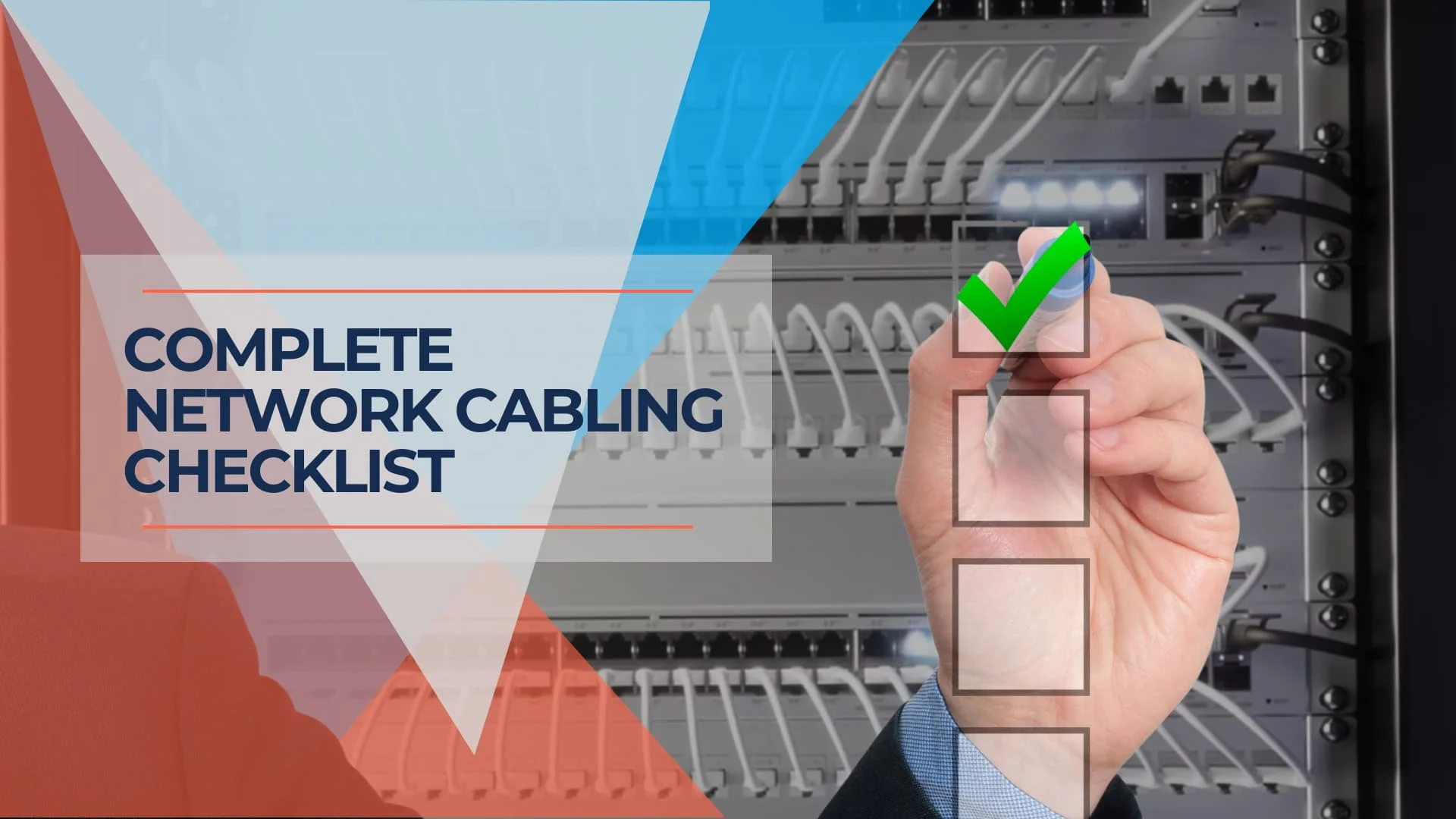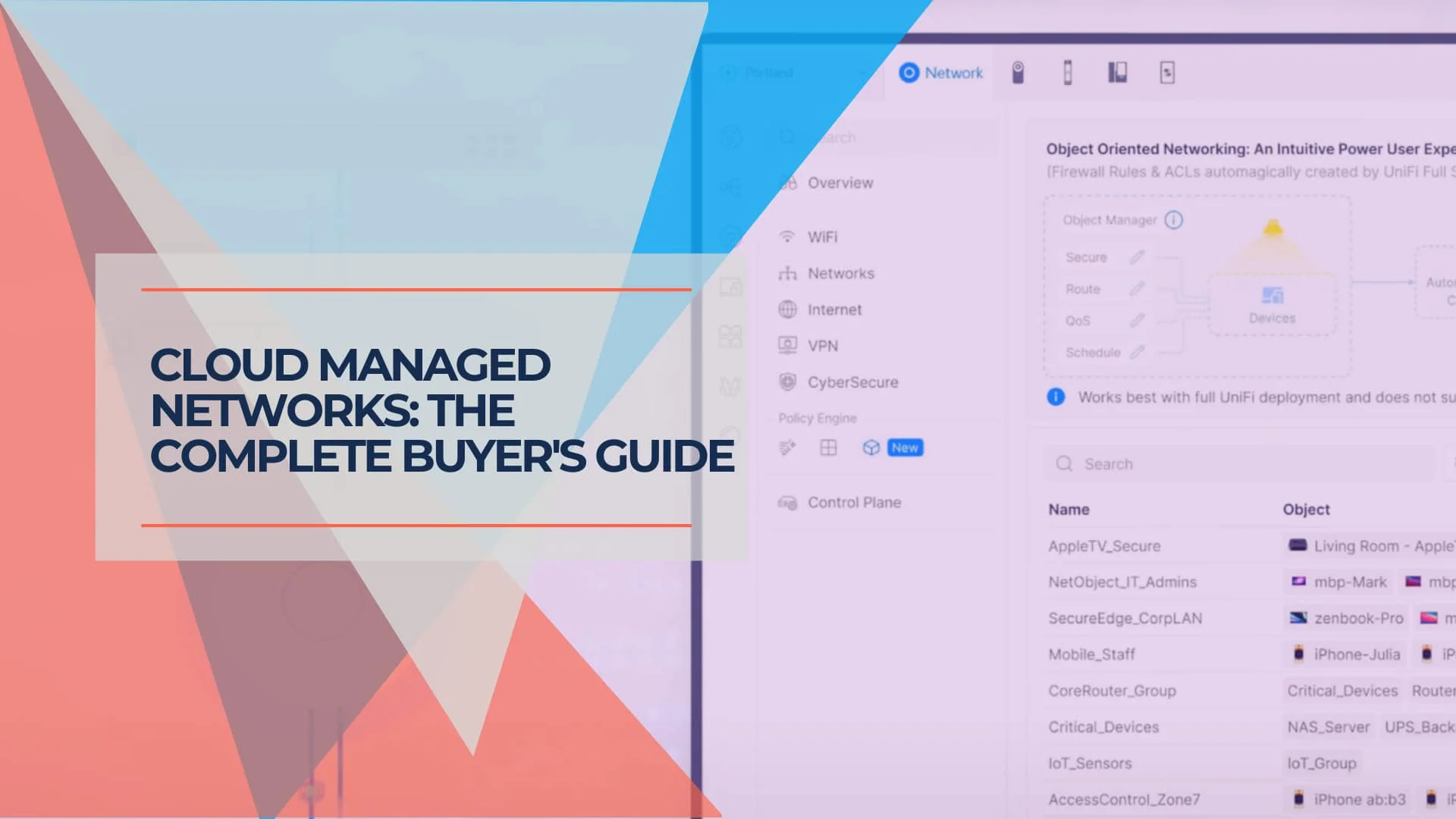Essential Network Cabling Checklist for 2024 (Free PDF)
Complete network cabling checklist for business owners. Learn cable selection, installation best practices, security considerations, and future-proofing strategies. Download our free PDF checklist.


Key Takeaway
A well-planned network cabling infrastructure is the foundation of reliable business connectivity. This checklist covers everything from planning and cable selection to installation best practices and future-proofing—plus a free downloadable PDF to guide your project.
Reliable connectivity is at the heart of any successful business. Whether you're managing a small office or a larger organization, a solid network cabling infrastructure is essential for keeping operations running smoothly. This guide presents a straightforward network cabling checklist to help you make informed choices and create a system to support your business long-term.
The Value of Proper Network Cabling
Network cabling is the foundation of communication within your business, impacting everything from internet reliability to data security. Well-planned cabling ensures your systems function smoothly, minimizing disruptions and maximizing productivity.
Many businesses face common issues like slow internet, frequent downtime, and even potential security vulnerabilities—all of which can often be traced back to inadequate cabling infrastructure. For instance, poor-quality or disorganized cabling can result in interference or performance inconsistencies that impact daily activities.
Having a clear plan is key to addressing these issues. A network cabling checklist helps you evaluate your current setup, understand necessary improvements, and plan for future needs. By approaching your cabling infrastructure methodically, you ensure it remains reliable and able to support growth or technology changes over time.
This blog post will walk you through essential steps, from planning and cable selection to installation best practices and future-proofing. By using this checklist, you can take a practical approach to creating a reliable and secure network.
Download our complete checklist at the end of this article to support your network infrastructure.
Planning and Assessment
Careful planning and assessment are essential before installing or upgrading your network cabling. A well-thought-out plan helps prevent unexpected issues and ensures that the cabling system meets your business's current and future needs.
Determining Network Requirements
The first step in planning is understanding your network's requirements. Consider the number of devices, the types of applications used, and the bandwidth needed to support them. For example, an office using video conferencing tools and cloud applications will need higher bandwidth than one relying primarily on email.
It's also important to anticipate future growth. Will you add more workstations, or is your business planning on adopting new technologies requiring more network capacity? Factoring in these aspects now will help you avoid costly upgrades.
Assessing Existing Infrastructure
If you already have a network in place, assessing the current infrastructure can reveal areas that need improvement. Are there bottlenecks affecting performance? Are cables showing signs of wear or disorganization?
Identifying these issues helps determine if upgrades are necessary and whether the existing setup can be improved to meet your needs efficiently. This step often involves documenting existing cable routes, verifying their condition, and ensuring compliance with industry standards.
Industry-Specific Considerations
Different industries have unique needs when it comes to network infrastructure:
- Healthcare facilities may require special setups for HIPAA compliance to keep patient information secure
- Schools might need to support high-density Wi-Fi for classrooms
- Retail businesses rely heavily on reliable Point of Sale (POS) systems
- Hospitality environments prioritize consistent guest Wi-Fi
Considering these industry-specific needs will guide you in choosing the right type of cables and ensuring a suitable setup for your business environment.
Cable Selection
Choosing the right cables is crucial for building a reliable network. The type of cable you select can affect your network infrastructure's performance, scalability, and longevity.
Choosing the Right Cable Category
Network cables come in different categories, each suited for specific purposes:
-
Cat6: As of 2024, Cat6 is the current standard for most business networks. It offers improved performance, supporting speeds up to 10 Gbps over shorter distances, making it ideal for businesses that require reliable and fast data transmission. Cat6 should be the primary choice when installing new cables to ensure future compatibility and performance.
-
Cat5e: This category suits moderate bandwidth needs, supporting speeds up to 1 Gbps. If Cat5e is already installed in the walls and the cable runs are short, it may still be sufficient, depending on your network type. However, it's best to avoid Cat5e and opt for Cat6 for new installations.
-
Cat6A: An upgraded version of Cat6, providing higher speeds over longer distances, which makes it a good choice for larger office environments.
-
Cat8: Used for high-speed data centers, supporting speeds up to 40 Gbps. It's typically overkill for most office networks but useful in environments with high bandwidth needs.
-
Fiber Optic: Ideal for long-distance runs and high-speed requirements. It provides higher bandwidth and is not susceptible to electromagnetic interference, making it suitable for environments with electrical equipment.
| Category | Maximum Speed | Bandwidth | Maximum Distance | Recommended Usage |
|---|---|---|---|---|
| Cat5e | 1 Gbps | 100 MHz | 100 meters (328 feet) | Basic office networks, email, web browsing |
| Cat6 | 10 Gbps | 250 MHz | 55 meters (180 feet) for 10 Gbps | Most business networks, video conferencing, cloud applications |
| Cat6A | 10 Gbps | 500 MHz | 100 meters (328 feet) | Larger office networks, high-speed data transfer over long distances |
| Cat8 | 40 Gbps | 2000 MHz | 30 meters (98 feet) | Data centers, high-performance networks |
| Fiber Optic | 100 Gbps or higher | N/A | Up to 40 km (24 miles) or more | Long-distance runs, high-speed, EMI-resistant environments |
The key is to select a cable category that matches your business's current and anticipated needs. For example, a growing business planning to implement more data-intensive applications should opt for Cat6 or Cat6A to ensure future compatibility.
Simple Guide to Selecting the Correct Ethernet Cable
Selecting the Appropriate Cable Jacket
The environment where cables are installed plays a big role in the type of cable jacket needed. Jackets come in different types, each designed for specific conditions:
- Riser: Suitable for vertical runs between floors in buildings
- Plenum: Required for spaces that facilitate air circulation for heating and cooling systems, as these cables are fire-resistant and emit less toxic smoke in case of a fire
- Outdoor: Designed to withstand the elements, including UV exposure and temperature variations
- Direct Burial: Specially designed to be buried underground without additional protection
Using the appropriate jacket is crucial for safety and compliance with building codes. For example, plenum-rated cables are mandatory in spaces used for air circulation, while outdoor-rated cables are needed for external installations.
Shielding Requirements
In some environments, electromagnetic interference (EMI) can be an issue, particularly in areas with high-voltage equipment. Choosing between shielded and unshielded cables can make a difference:
-
Shielded Cables (STP): Ideal for environments with high EMI, such as factories or areas near power lines. They come with an additional layer to block interference.
-
Unshielded Cables (UTP): Suitable for most office environments without significant EMI sources, offering more flexibility and easier installation.
Understanding your workspace helps determine if shielding is necessary to maintain signal quality and minimize interference.
Installation Best Practices
Once you've selected the appropriate cables, proper installation is key to ensuring optimal performance and longevity. Following best practices during installation helps prevent issues like signal loss, cable damage, and costly maintenance down the road.
Proper Cable Routing and Support
Cables should be routed to avoid stress and potential damage. Use cable trays, racks, or other types of support to keep cables organized and prevent tangling or strain. Sharp bends, which can weaken cables over time, leading to poor performance or even breakage, should also be avoided.
A well-organized system extends the life of your network cabling and makes future upgrades and troubleshooting easier.
Maintaining Separation from Electrical Wiring
One common mistake during network cabling installation is running data cables too close to electrical wiring. This can cause electromagnetic interference (EMI), degrade signal quality, and lead to slower network speeds or disruptions.
Important
Data cables should be kept at least 12 inches away from electrical wires to minimize interference wherever possible. In environments where this isn't feasible, shielded cables may be required to protect against interference.
Labeling and Documentation
Clear labeling and thorough documentation of your cabling system are essential for efficient network management. Each cable should be labeled at both ends, and detailed records should be kept on cable routes, connection points, and ports.
This makes future troubleshooting and maintenance much simpler. Well-documented systems save time and prevent confusion if repairs or upgrades are needed.
Testing and Certification
After installation, testing all network cables to ensure they are working correctly is important. Use a cable tester to verify the integrity of each connection, checking for any potential issues like signal loss or improper grounding.
Certification tools can also confirm that the cabling meets industry standards. Proper testing helps catch issues early, preventing costly network problems down the line.
Security Considerations
A secure network begins with physical security. While much of network security focuses on software and firewalls, the physical security of your network cabling and infrastructure is equally important. Implementing proper safeguards can prevent unauthorized access and tampering with critical network components.
Securing Cable Entry Points
One of the simplest yet often overlooked security measures is securing the entry points of your network cabling. This means ensuring network cables are not easily accessible to unauthorized personnel.
Locking network closets and controlling physical access to where cables enter your building or office is an effective first step. Restricting access reduces the risk of malicious activity or accidental interference with your network.
Using Tamper-Evident Enclosures
Tamper-evident enclosures provide an additional layer of protection for critical network equipment, such as switches or routers. These enclosures are designed to show clear signs if someone attempts to open or alter them, alerting you to potential security breaches.
In environments where sensitive data is handled, such as healthcare or finance, using tamper-evident enclosures helps ensure compliance with data protection regulations.
Physical Security Measures
Beyond securing cabling and equipment enclosures, consider broader physical security measures like installing surveillance cameras in areas where network cabling is concentrated, such as data centers or server rooms.
Additionally, implementing access control systems—such as key cards or biometric scanners—can limit who has direct access to your network infrastructure. This is especially important for businesses handling sensitive information or critical operations, where minor disruptions can lead to significant consequences.
Maintenance and Future-Proofing
A well-installed network is only as good as its ongoing maintenance. Regular inspections and an eye toward future technological advancements are essential to ensure long-term reliability and performance. Proactive maintenance and planning can save your business from unexpected disruptions and costly upgrades.
Regular Inspections
Routine checks on your network cabling can help identify issues before they lead to downtime or performance problems. Inspect cables for signs of wear, such as fraying or loose connections, and check for environmental hazards like excessive heat or moisture that could damage your network.
Regular inspections allow you to catch and resolve problems early, keeping your network running smoothly.
Planning for Scalability
As your business grows, your network needs will likely evolve. Planning for scalability during the initial installation can save time and money in the long run.
When selecting components, choose modular systems that allow for easy expansion. Ensuring sufficient space in cable trays and network racks for future cabling is another way to prepare for growth without needing significant overhauls.
Staying Updated on Emerging Technologies
Technology is always advancing, and keeping an eye on emerging trends can help you stay ahead of the curve:
- Wi-Fi 7 and the 6 GHz spectrum are set to become important in the coming years, offering higher speeds and better performance
- With the rise of edge computing, more businesses are moving to distributed network models that require efficient cabling solutions
Staying informed about these changes ensures your network can support new technologies without needing frequent, costly upgrades.
Conclusion: A Reliable Network Starts with the Right Cabling
A well-planned network cabling infrastructure is the foundation of a reliable, secure, and scalable business network. By following this checklist—from planning and cable selection to installation, security, and maintenance—you can ensure your network is ready to meet current demands and adapt to future growth.
Need Professional Help?
If you need professional assistance, don't hesitate to contact iFeeltech. We specialize in network cabling and can help design and install a system that works for your business.
Download the Free Checklist
Get our complete network cabling checklist to guide your next infrastructure project:
This checklist reflects current industry standards as of October 2024. Cable specifications and best practices may evolve as new technologies emerge.
Related Articles
More from Network Infrastructure

Professional WiFi 7 Network Implementation: Complete Business Guide
Complete guide to professional WiFi 7 network implementation for businesses. Covers infrastructure planning, UniFi equipment selection, cost analysis, and implementation best practices.
12 min read

Business Internet Requirements Calculator: How Much Speed Do You Actually Need?
Calculate your business internet requirements based on employees, video calls, and cloud apps. Get the right speed without overpaying.
17 min read

Best Centrally Managed Network Systems 2025: UniFi, Cisco Meraki, Omada & More
Complete comparison of centrally managed network platforms for small business. Covers UniFi, Cisco Meraki, TP-Link Omada, Zyxel Nebula, and Firewalla with cost analysis and recommendations.
24 min read